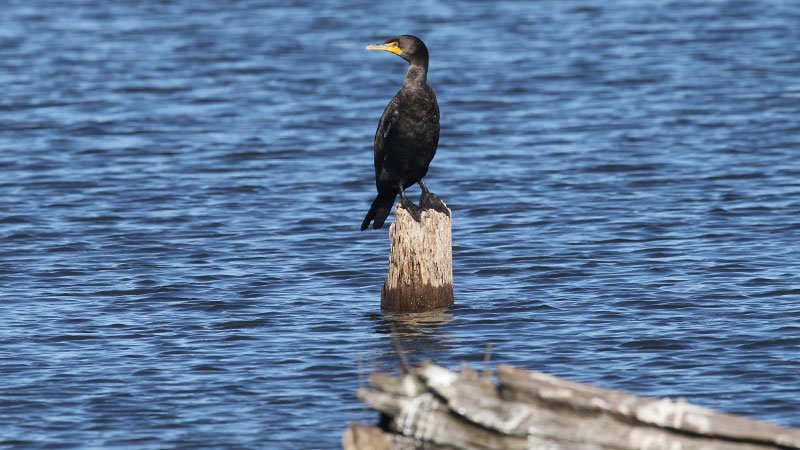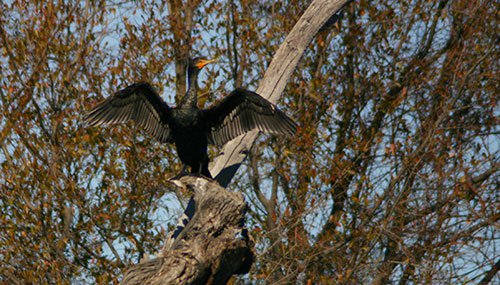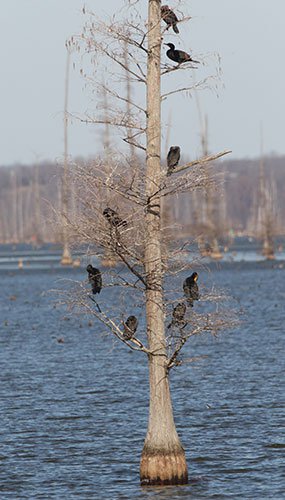Fish and Wildlife Service asking for public input on cormorant management
ON 01-22-2020

Jan. 22, 2020
Randy Zellers
Assistant Chief of Communications
WASHINGTON – As part of ongoing efforts to address conflicts between double-crested cormorants and wild and stocked fisheries, the U.S. Fish and Wildlife Service is asking for public input on future management options.

“Balancing the protection of native wildlife with economic and human health needs is fundamental to effective management practices,” said U.S. Secretary of the Interior David Bernhardt. “Today’s action starts the process of improving management and further reduces conflicts with double-crested cormorants throughout the United States.”
Future management actions built on a strong biological foundation ensure cormorant populations are managed responsibly and in compliance with federal laws and regulations, while balancing economic development, human health and safety, endangered species management and other priorities.
“We are building long-term solutions for managing conflicts with double-crested cormorants under the Migratory Bird Treaty Act while maintaining healthy populations of this species,” said Aurelia Skipwith, Director of the USFWS. “This effort, in collaboration with our partners, will ensure continued good stewardship of our natural resources.”
In 2017, the USFWS completed an environmental assessment under the National Environmental Policy Act evaluating options for issuing individual depredation permits to provide relief for aquaculture facilities experiencing direct economic losses from cormorants across 37 central and eastern states and the District of Columbia.
The assessment analyzed options for the issuance of depredation permits for cormorants where there is either significant economic damage to aquaculture facilities, significant damage to native vegetation, significant impact on a threatened or endangered species, or significant human safety risks.
This review did not include potential damage to recreational and commercial fishing by cormorants. Since the publication of the assessment, the USFWS engaged stakeholders to assess the biological, social and economic significance of wild fish-cormorant interactions, and to identify management alternatives.

“With nearly 30,000 water surface acres across Arkansas used for aquaculture production, our fish farmers contributed $71.1 million to our state’s economy in 2017. However, the United States Department of Agriculture estimates double-crested cormorants cause more than $25 million in damage annually within the aquaculture industry. These birds have become the foremost antagonists of fish farmers. We need common sense solutions that allow aquaculture producers to safeguard their fish from these predators,” said U.S. Sen. John Boozman (AR). “I applaud the U.S. Fish and Wildlife Service for responding to the need of aquaculture producers by increasing the amount of maximum allowable take of double-crested cormorants, and I look forward to working with the Department of Interior and USFWS to ensure we can find common sense solutions to ease the burden for hard-working Arkansan aquaculture producers.”
“Arkansans are experiencing the harmful impact of double-crested cormorants across the state. As one of the top aquaculture producers in the nation, Arkansas and its fish farmers are suffering millions of dollars in losses as these avian predators consume critical inventory,” said U.S. Sen. Tom Cotton (AR). “I am glad the Department of Interior is taking this problem seriously and hope that further progress will come swiftly.”
“Science has consistently proven that managing cormorants is necessary to protect not just aquaculture but fishing as well. I applaud the administration for listening to input, increasing the take and promoting sound scientific practices,” said U.S. Rep. Bruce Westerman (AR-04).
“The strong return of double-crested cormorants is a significant conservation success. But in the absence of natural predators, cormorants are inflicting substantial depredation on both private and public aquatic resources. This effort by the Fish and Wildlife Service is necessary and appropriate to maintain a healthy ecosystem,” said Former Director, U.S. Fish and Wildlife Service Dale Hall.
Public scoping for the rulemaking process will begin Jan. 22, and will continue until March 9. Comments will only be accepted through one of the following methods. Please do not submit comments by both.
- Electronically: Go to the Federal eRulemaking Portal: http://www.regulations.gov. Follow the instructions for submitting comments to Docket No. FWS-HQ-MB-2019-0103.
- By hard copy: Submit by U.S. mail or hand-delivery to Public Comments Processing, Attn: FWS–HQ–MB–2019–0103; U.S. Fish and Wildlife Service Headquarters, MS: JAO/1N, 5275 Leesburg Pike, Falls Church, VA 22041–3803.
The USFWS seeks comments or suggestions from the public, governmental agencies, tribes, the scientific community, industry or any other interested parties. Areas for consideration include but are not limited to: potential reporting and monitoring strategies of cormorants by states and participating tribes; impacts on floodplains, wetlands, wild and scenic rivers or ecologically sensitive areas; impacts to other species of wildlife, including endangered or threatened species; and impacts on prime agricultural lands. Please see the Federal Register notice for more details.
The Fish and Wildlife service will post all comments on http://www.regulations.gov, including any personal information you provide. The Service will hold public scoping meetings in the form of multiple webinars in February 2020.
More information about the rulemaking process, cormorants and meetings, including how to register, will be posted online at https://www.fws.gov/birds/management/managed-species/double-crested-cormorants.php.
Recent News
Subscribe to Our Weekly Newsletter E-mails
Don’t miss another issue. Sign up now to receive the AGFC Wildlife Weekly Newsletter in your mailbox every Wednesday afternoon (Waterfowl Reports are published weekly during waterfowl season and periodically outside the season). Fishing Reports arrive on Thursdays. Fill in the following fields and hit submit. Thanks, and welcome!


